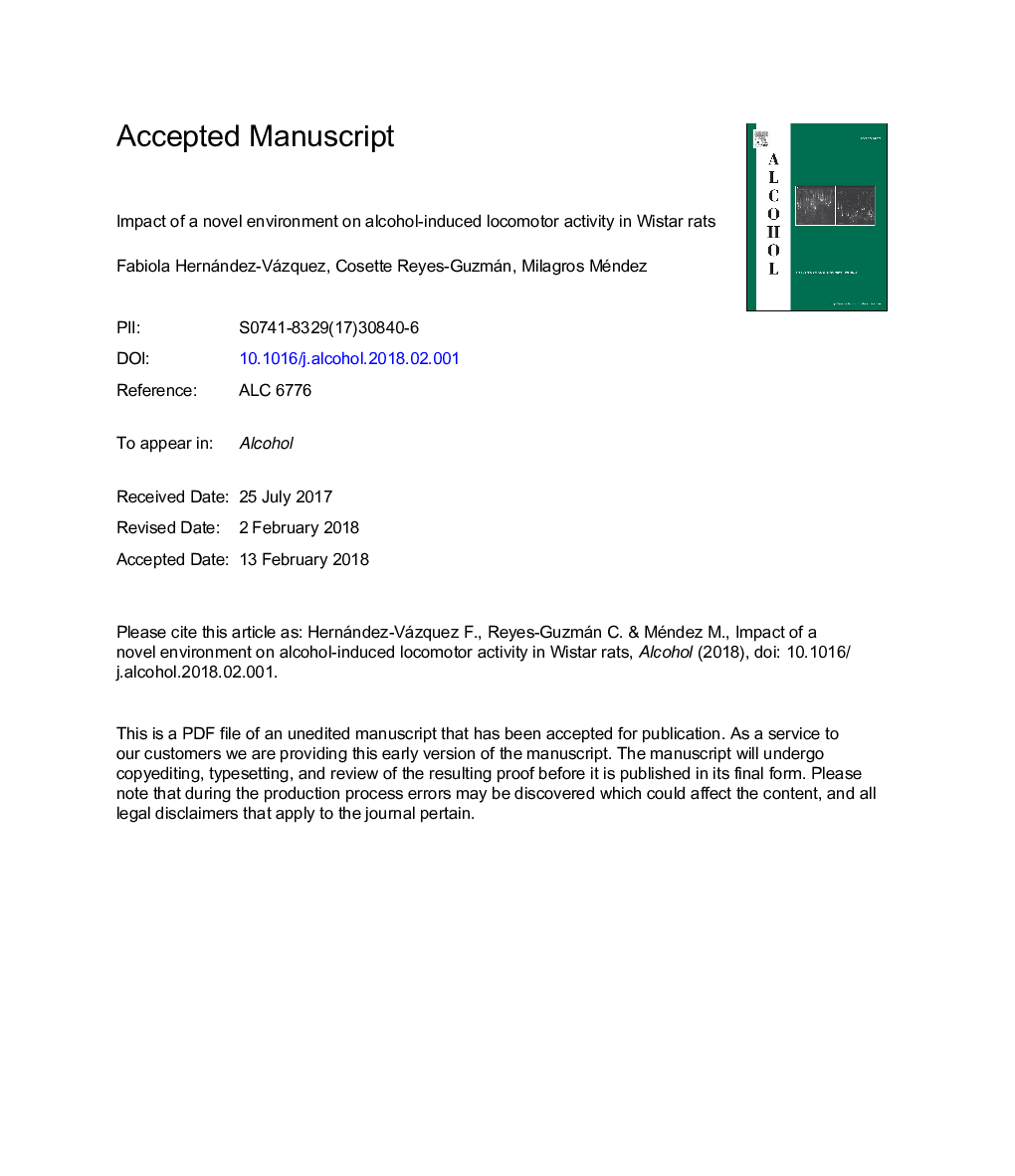| کد مقاله | کد نشریه | سال انتشار | مقاله انگلیسی | نسخه تمام متن |
|---|---|---|---|---|
| 7501318 | 1485958 | 2018 | 32 صفحه PDF | دانلود رایگان |
عنوان انگلیسی مقاله ISI
Impact of a novel environment on alcohol-induced locomotor activity in Wistar rats
ترجمه فارسی عنوان
تاثیر محیط جدید بر فعالیت حرکتی القایی در موش های صحرایی ویستار
دانلود مقاله + سفارش ترجمه
دانلود مقاله ISI انگلیسی
رایگان برای ایرانیان
کلمات کلیدی
الکل، اتانول، فعالیت موتور، نوآوری، پاسخگوهای کم پاسخ دهنده بالا
موضوعات مرتبط
علوم زیستی و بیوفناوری
بیوشیمی، ژنتیک و زیست شناسی مولکولی
زیست شیمی
چکیده انگلیسی
Clinical studies have shown a positive correlation between novelty-seeking behavior and the susceptibility to consume drugs of abuse. Although several animal studies have demonstrated this correlation with psychostimulants or morphine, studies with alcohol have shown conflicting results. The aim of this work was to investigate alcohol-induced motor effects in Wistar rats with different responses to novelty. Animals were classified as Low- (LR) or High-Responders (HR) to novelty, depending on their horizontal activity in an automated open field. Motor activity was recorded in naïve, saline, and alcohol-administered rats at different doses (0.1, 0.25, 0.5, 1.0, or 2.5Â g/kg). Horizontal movements, rearings, and stereotyped behaviors were evaluated. After the behavioral test, animals were sacrificed and blood alcohol concentrations (BACs) were measured. Low (0.1 and 0.25Â g/kg) and high (2.5Â g/kg) alcohol doses decreased horizontal movements in LR animals, whereas 1.0Â g/kg increased this parameter in HR rats. Rearings were increased by alcohol 1.0Â g/kg in LR animals. In HR rats, alcohol doses of 0.5 and 1.0Â g/kg also increased this parameter. Stereotyped behaviors were decreased by an alcohol dose of 2.5Â g/kg in LR animals, but were increased by an intermediate dose (1.0Â g/kg) in HR rats. Differences in horizontal movements and rearings were found between LR and HR animals at certain ethanol doses. Horizontal movements (0.25Â g/kg) and rearings (0.5Â g/kg) were lower in LR than HR rats; however, rearings were lower in HR than LR rats at 1.0Â g/kg. BACs were similar between LR and HR rats at all ethanol doses. These findings suggest that HR rats are more responsive to the stimulant effects of intermediate alcohol doses, whereas LR animals are sensitive to low/high doses of the drug. Sensitivity to alcohol motor effects may substantially depend on the initial animal's response to a novel environment. The stimulant effects of alcohol may constitute important behavioral traits significantly associated with the rewarding properties of the drug.
ناشر
Database: Elsevier - ScienceDirect (ساینس دایرکت)
Journal: Alcohol - Volume 71, September 2018, Pages 5-13
Journal: Alcohol - Volume 71, September 2018, Pages 5-13
نویسندگان
Fabiola Hernández-Vázquez, Cosette Reyes-Guzmán, Milagros Méndez,
